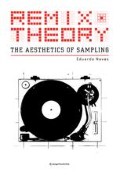Abstract
This chapter defines three basic forms of Remix in music and evaluates how they extend as a fourth form in art and media. I evaluate the principles of Remix against a set of new media art projects. I point out as necessary when a project is informed by remix, as well as when it is a remix in its own right, even when the author does not call it a remix. The chapter also examines the role of Remix in media. My particular examples are software mashups, defined as a combination of two pre-exisiting software applications; I then link mashups to the activity of blogging, commonly known as a form of online journal writing. To show how Remix principles take effect as conceptual strategies, as defined in the introduction, blogging is also linked to literature and appropriation art. Let us now define Remix to understand its complex role in art, media and culture.
Preview
Unable to display preview. Download preview PDF.
References
This is my own definition extending Lawrence Lessig’s definition of remix culture based on the activity of “Rip, Mix and Burn.” Lessig is concerned with copyright issues; my definition of Remix is concerned with aesthetics and its role in political economy. See Lawrence Lessig, The Future of Ideas (New York: Vintage, 2001), 12–15.
I use the term “spectacular” after Guy Debord’s theory of the Spectacle, and Walter Benjamin’s theory of aura. We can note that the object develops its cultural recognition, not on cult value, but exhibit value (following Benjamin), because it depends on the spectacle (following Debord) for its mass cultural contribution. See, Walter Benjamin, “The Work of Art in the Age of Mechanical Reproduction,” Illuminations (New York, Schocken, 1968), 217–251; Guy Debord, The Society of the Spectacle (New York: Zone Books, 1995), 110–117.
Brewster, 178–79.
Paid in full was actually a B side release meant to complement “Move the Crowd.” Eric B. & Rakim, “Paid in Full,” Re-mix engineer: Derek B., Produced by Eric B. & Rakim, Island Records, 1987.
Poschardt, 297.
Hebdige, 12–16, see chapter two for full citation, 37.
Owens, 223, see chapter two for full citation, 36.
Ibid.
Underworld, “Born Slippy,” Single EP, TVT, August 1996.
Kraftwerk, Tour De France Soundtracks, Astralwerks, August 2003.
Lessig has written a number of books on this subject. The most relevant to the subject of creativity and intellectual property: Lawrence Lessig, Free Culture (New York: Penguin, 2004).
Mike Snider, “Maya Muscles its Way into Hollywood film awards,” USA Today, March 25, 2003, http://www.usatoday.com/life/movies/movieawards/oscars/2003-03-19-maya_x.htm.
Kate Armstrong and Michael Tippett, “Grafik Dynamo,” Turbulence.org, 2005, http://turbulence.org/Works/dynamo/index.html.
Golan Levin, et. al, “The Secret Lives of Numbers,” Turbulence.org, 2002, http://turbulence.org/Works/nums/index.html.
Owens, 206.
Poul Erik Tojner, “I know You Must Feel,” Michael Juul Holm, Poul Erik Tojner and Martin Caiger-Smith, Editors, Roy Lichtenstein: All About Art (Lousiana: Lousiana Museum of Art, 2003), 11–31.
For an image of Grotesque visit Adam Art Gallery http://www.vuw.ac.nz/adamartgal/exhibitions/2002/big/lightsandshadows-hoch-lg.html. Also see, Maria Makela and Peter Boswell, editors, The Photomontages of Hannah Höch (Minneapolis: Walker Art Center, 1997), 174.
Jean-François Lyotard, The Postmodern Condition: A Report on Knowledge (Minneapolis, Minnesota: 1984), 3–67.
Fredric Jameson, Postmodernism or, The Logic of Late Capitalism (Durham: Duke University Press, 1991), 4.
Jameson, 9.
Ibid, xviii
Ibid, 10.
Peter Bürger, Theory of the Avant-Garde (Minneapolis: University of Minnesota Press, 1984), 88–91.
Attali, 7, for a previous discussion on Attali see introduction, 5–8, and chapter two, 60–61.
Ibid, 11.
Adorno, 51, see discussion of Adorno in chapter one, 27.
Ibid, 32
Jameson, ix.
Sasha Frere-Jones, “1+1+1=1: The New Math of Mashups,” The New Yorker, 10 January, 2005, http://www.newyorker.com/archive/2005/01/10/050110crmu_music.
Grandmaster Flash, “The Adventures of Grandmaster Flash on the Wheels of Steel,” 12 inch single, Sugarhill Records, 1981.
Mark Vidler, “Ray of Gob” for more information on the mashup see Go Home Productions, 2006, http://www.gohomeproductions.co.uk/history.html.
Corey Moss, “Grey Album Producer Danger Mouse Explains How He Did It” MTV, May 11, 2004, http://www.mtv.com/news/articles/1485693/20040311/danger_mouse.jhtml.
These are citations based on my own travels to different cities. The buildings with images can be found in any major city. For information about cigarettes see: Liz Borkowski, “The Face of Chile’s Anti-Tobacco Campaign: The Pump Handle” Posted on January 4, 2007, http://thepumphandle.wordpress.com/2007/01/04/the-face-of-chiles-anti-tobacco-campaign/. For an image of the Spider-Hulk see: “The Incredible Hulk Engine of Destruction,” http://www.incrediblehulk.com/spiderhulk.html.
Duane Merrill “Mashups: The new breed of Web App. An Introduction to Mashups,” IBM, October 16 2006, http://www-128.ibm.com/developerworks/web/library/x-mashups.html.
Ibid
Brewster, 224–25.
Poschardt, 58–62.
Attali, 133–148
Charles Mudede, “The Turntable,” ctheory.net, April 24, 2003, http://ctheory.net/text_file?pick=382.
Adorno, 29–60.
Jorge Luis Borges, “Pierre Menard, Author of the Quixote,” in Collected Fictions, trans. Andrew Hurley (New York: Penguin, 1999), 94.
Ibid.
Ibid.
Owens, 203.
Rosalind Krauss, “The Originality of the Avant-Garde,” The Originality of the Avant-Garde and Other Modernist Myths (Cambridge, Massachusetts and London, England: 1999), 168.
Tracy McMullen, “Identity for Sale: Glenn Miller, Wynton Marsalis and Cultural Replay in Music,” Big Ears: Listening for Gender in Jazz Studies (Refiguring American Music), ed. Nichole T. Rustin and Sherrie Tucker (Durham: Duke University Press, 2009), 214.
Richard Koman, “Remixing Culture, an Interview with Lawrence Lessig,” February, 24 2005, http://www.oreillynet.com/pub/a/policy/2005/02/24/lessig.html.
Ibid, “The Author as Producer,” Reflections (New York: Schocken, 1978), 225.
Barbara Blood, “Weblogs: A History and Perspective,” Rebecca’s Pocket, September, 2000, http://rebeccablood.net/essays/weblog_history.html.
John Stiler, “Blogosphere: the Emerging Media Ecosystem,” Microcontentnews.com, May 28 2002, http://www.microcontentnews.com/articles/blogosphere.htm.
Richard Barbrook, “The High Tech Economy,” First Monday, 1998 and 2005, http://www.uic.edu/htbin/cgiwrap/bin/ojs/index.php/fm/article/view/631/552.
Tim Berners-Lee and Mark Fischeti, Weaving the Web (New York: Harper Collins, 1999), 84.
Author information
Authors and Affiliations
Rights and permissions
Copyright information
© 2012 Springer-Verlag/Wien
About this chapter
Cite this chapter
Navas, E. (2012). Remix[ing] Theory. In: Remix Theory. Springer, Vienna. https://doi.org/10.1007/978-3-7091-1263-2_4
Download citation
DOI: https://doi.org/10.1007/978-3-7091-1263-2_4
Publisher Name: Springer, Vienna
Print ISBN: 978-3-7091-1262-5
Online ISBN: 978-3-7091-1263-2

